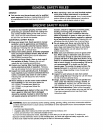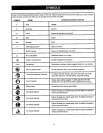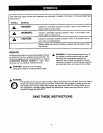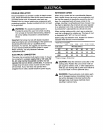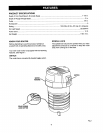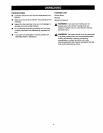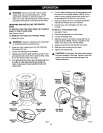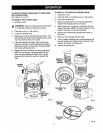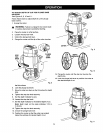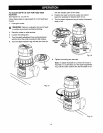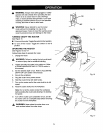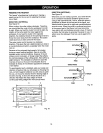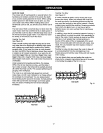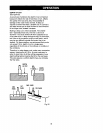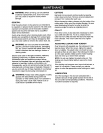
REMOVING/INSERTING cu'n'ERS
See Figure 7,
Followthese steps to remove or insertcutters.
1. Unplug the router.
_, WARNING: Failureto unplug the tool could result
in serious injurydue to accidentalstarting.
TO
LOOSEN
CAUTION: To prevent damage to the spindle or
spindle lock, always allow motor to come to a
complete stop before engaging the spindle lock.
2. Lay the router down on a workbench in order to
gain easy access to collet nut.
3. Depress and hold the spindle lock button.
4. Loosen the collet nut by turning it counterclockwise
with the wrench provided.
WARNING: If you are changing a cutter
immediately after use, be careful not to touch the
cutteror collet with your hands or fingers. Always
use the wrench provided.
5. Choose one of these options:
• To remove the cutter: Remove the cutterfrom the
collet.
• To insert the cutter:
a) Insert the shank of the cutter until the shank
bottoms out, then pull it out 1/16 in. (1.6 mm)
to allow for expansion when the bit gets hot.
b) Tighten the collet nut securely by turning it
clockwise with the wrench provided.
c) Release the spindle lock button.
WARNING: If the collet nut is not securely
tightened, the cutter may detach during use
causingserious personal injury.
• i, WARNING: Do not use cutters with undersized
shanks. Undersized shanks willnot tighten properly
and couldbe thrown from the tool causinginjury.
_1= WARNING: Do not use cutters that are larger in
diameter than the opening in routerbase. Use of
such cutterswill come in contact withthe router
base and damage both the cutterand routerbase.
This situation couldalso cause possibleloss of
controlor create other hazardous conditionsthat
couldcause possible seriouspersonal injury.
TO
TIGHTEN
SPINDLE
LOCK
BU'FFON
Fig. 7
ADJUSTING DEPTH OF CUT
Proper depth of cut depends on several factors: the
horsepower of the routermotor,the type ofcutter, and
the type of wood. A lightweight, low horsepower routeris
designed for making shallowcuts.A routerwith a high
horsepower ratingcan safely cut deeper. Small cutters,
such as veining bitswith 1/16 in. (1.6 mm) cutting
diameters, are designed to remove only small amounts
of wood. Large cutters, such as straight-flutebits, are
made to remove larger amounts of wood. You can make
deeper cuts in soft woods, such as white pine, than in
hardwoods,like oak or maple.
Based on these considerations,choose a depth of cut
that will not place excessive strain on the router motor.If
you find that extra force is needed or that the motor
speed stows downconsiderably,turn offthe routerand
reduce the depth of cut. Then, make the cut intwo or
more passes.
When routinga groove that is too deep to safely cut in
one pass, it isbest to make the cutin several passes.
We recommend that cuts be made at a depth not
exceeding 1/8 in. (3.2 mm) and that several passes be
made to reach deeper cuts.
Adjustingthe depth of cut for the plunge routeris
differentfrom adjustingthe depth of cut for the fixed
router.
12



